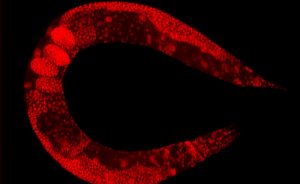By Monika Buczek
In the past decade, the human gut microbiome has has been implicated in many diseases, including but not limited to food allergies, celiac disease, diabetes, and certain autoimmune diseases as well as weight gain and obesity. However, study of the gut microbiome is slowed by a lack of adequate model systems in which to observe changes to both host and gut flora under certain conditions. Recently however, the nematode C. elegans has been identified as a possible model for studying the effect of the microbiome on metabolism- and subsequently how those changes to metabolism affect certain disease states.
Caenorhabditis elegans has long been used a research model organism for aging, autophagy, apoptosis and even diabetes, but the nematode may have a further function in determining the role of the gut microbiome in host metabolism. This tiny worm uses environmental cues to determine if the time is right to reproduce, or if conditions call for entering a type of dormancy called Dauer Diapause, a long-term stress-resistant stage in the C. elegans life cycle. Environmental temperature, population density, availability of food as well as chemical signals from pheromones and, as we are currently learning, bacteria are all important factors that help determine the worm’s choice between active reproduction and Dauer. However, until recently, the exact effect of bacterial genes on Dauer wasn’t quite clear.

Figure 1: The model organism and nematode Caenorhabidis elegans moving through medium Source

Figure 2: The nuclei of each cell in C. elegans are stained with Texas Red in this image from The Evolution of Self-Fertile Hermaphroditism: The Fog Is Clearing
A team of researchers from the Buck Institute for Research on Aging have identified a slew of gene mutations in E. coli K-12 that enhance the transition of C. elegans into Dauer state, sometimes resulting in increased life span. Specifically, the group identified certain E. coli mutants that increase the transition of the C. elegans insulin-like receptor mutant, daf-2, into Dauer.
Insulin signaling is well-conserved across the animal kingdom. While humans have several insulin receptors, the DAF-2 protein is the only member of the insulin receptor family in C. elegans. It holds 35% identity in protein sequence to the human insulin receptor, 34% to the human IGF-1 receptor and and 33% to human insulin. Human insulin and orthologous insulin-like genes in C. elegans inhibit DAF-2 receptors in C. elegans, which leads to activation of Dauer stage. The daf-2 mutant similarly arrests C. elegans development and redirects the worm’s life cycle into Dauer, which increases longevity and prevents reproductive maturity. The goal of this study was ultimately to observe which E.coli single gene mutations and their associated changes in metabolites, increased the rate at which both wild type and daf-2 mutant C. elegans entered into Dauer.
The Buck Institute group screened around 4,000 strains of E. coli from the Keio Collection, a collection of single-gene deletions of all nonessential genes in Escherichia coli K-12.Each strain in this collection has only one gene knocked out at a time.The Buck institute group fed the E.coli Keio mutants to various C. elegans strains and the group identified 56 genes that enhance Dauer formation in daf-2 mutants. Certain E. coli mutants, such as the cya mutant, which is deficient in the ability to produce cyclic AMP, were even able to increase the lifespan of wild type C. elegans as well as the daf-2 mutant counterpart. This work is important because it demonstrates how even one bacterial gene mutation is capable of altering the physiology of the host organism.
The group believes studying the bacterial-host interactions may be applicable to host-microbiome interactions in other species. The function of certain bacteria has been well described in several human diseases including obesity,liver diseases, metabolic syndrome, autoimmune disorders like food allergies, and diabetes.
A particular application of this research is elucidating how the human gut microbiome affects nutrient uptake and alters the phenotypes of certain genetic mutations. The authors state “interaction between bacteria and C. elegans can be used to understand conserved signals that are likely to play a role in host-microbiome interactions in humans which may influence diseases like Type II diabetes and obesity.”
All in all, a new and easily tractable model for human microbiome research and disease is a very welcome addition to the vast and quickly evolving field of research.
Monika Buczek is a PhD candidate in molecular biology and an associate writer for the American Society for Microbiology.
Author Contact: msbuczek@gmail.com
Editor: Julija Hmeljak
